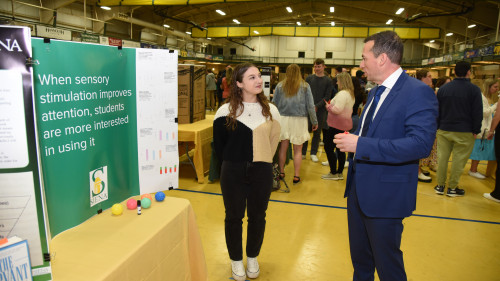

Siena College Assistant Professor of Physics John Moustakas, Ph.D. was recently awarded two grants from the Space Telescope Science Institute to analyze observations obtained using NASA’s premier space-based observatory, the Hubble Space Telescope.
A grant worth $20,715 was awarded to Moustakas last month to analyze data from one of the largest programs ever conducted with the Hubble, the “Cluster Lensing And Supernova survey with Hubble,” or CLASH.
CLASH is an ongoing, three-year survey designed to tackle the most challenging unanswered questions in astrophysics. As a core team member of the international CLASH collaboration, Moustakas’ work aims to understand how the oldest and most massive galaxies in the Universe formed.
“The biggest, oldest, and most massive galaxies in the Universe live at the centers of enormous galaxy clusters, surrounded by thousands of smaller galaxies and large amounts of dark matter,” Moustakas said. “We still do not understand how the stars in these galaxies formed, or whether these galaxies grew to be so big by cannibalizing other galaxies.”
Two months ago, Moustakas was awarded a grant worth $15,390 from the Space Telescope Science Institute to analyze observations obtained as part of another program with the Hubble. Through this award, Moustakas and his Siena colleague, Associate Professor of Physics Rose Finn, Ph.D. will work with researchers from other institutions, including the University of Arizona, California Institute of Technology, University of Kansas and Osservatorio Astronomico di Padova (Italy).
“Our collaboration was awarded 28 ‘orbits’ of observing time, equivalent to roughly two continuous days of observing with the Hubble,” Moustakas said, adding that it is a considerable amount of time for a medium-sized program.
The scientific goal of Moustakas’ project is to determine why galaxies “transform” when they are gravitationally pulled into large cosmic structures called galaxy clusters. “When an actively star-forming spiral galaxy – like our own Milky Way galaxy – falls into a cluster, it quickly stops forming stars and changes into what are affectionately called ‘red and dead’ elliptical galaxies,” Moustakas said. He added that astronomers do not understand how this transformation happens. Leveraging the Hubble Space Telescope’s exquisite power will allow Moustakas’ group to make significant headway toward understanding this important question for galaxy evolution studies.
Galaxy evolution is the focus of Moustakas’ research. His work aims to improve the understanding of how galaxies formed and evolved over the 14-billion-year age of the Universe. Moustakas specifically measures the physical properties of galaxies, including their shapes, sizes, masses, colors, and stellar content. Studying these properties helps him infer the past and future evolutionary histories of galaxies. Moustakas plans to include Siena College students in both research projects.

